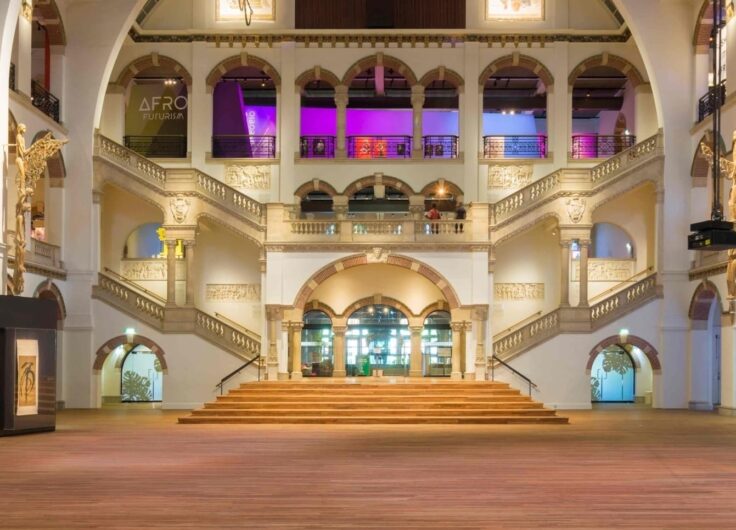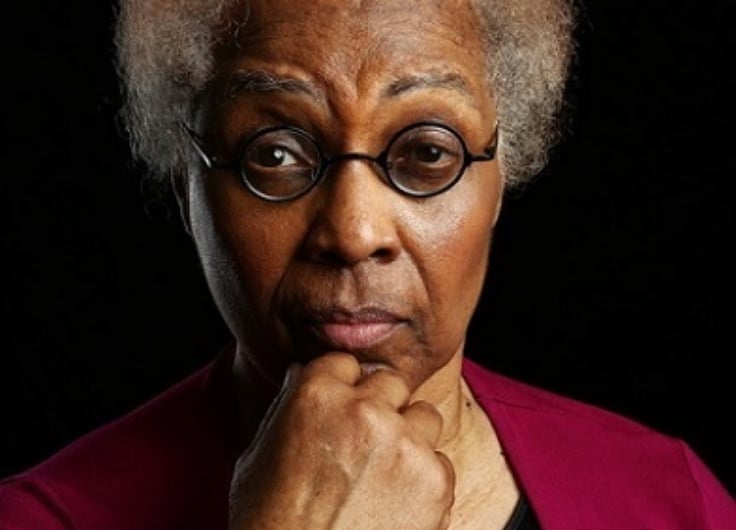Who Gave the Most Royal Corona Speech?
During the corona crisis, several European monarchs have given speeches to encourage the public. Not only what they said, but how
they said it, deserves some attention. Did Willem-Alexander’s concern and Filip’s stiffness lend power to their words, or not? What about the props in the background; the books, portraits and candles? By putting the background in the foreground, we can discover the image strategies that were behind the outward appearances and determine who gave the best speech.
Sometimes a crisis hits so hard that the need for comforting words becomes pressing. When the corona storm broke over Europe in March 2020, it rattled the royal palaces. Monarchs are ready to make the usual speeches at the opening of parliament and deliver the traditional addresses at Christmas and New Year – but a prime time televised crisis speech to the entire nation is not so straightforward and does not happen often.
For those with a historical bent, the crisis calls up memories of Queen Wilhelmina’s wartime radio broadcasts or even the halting speeches of George VI: times when people were longing for comfort during frightening events and hopeful messages of better days ahead. Kings and queens who spoke via the medium of the day – the wireless – became symbols of unity.
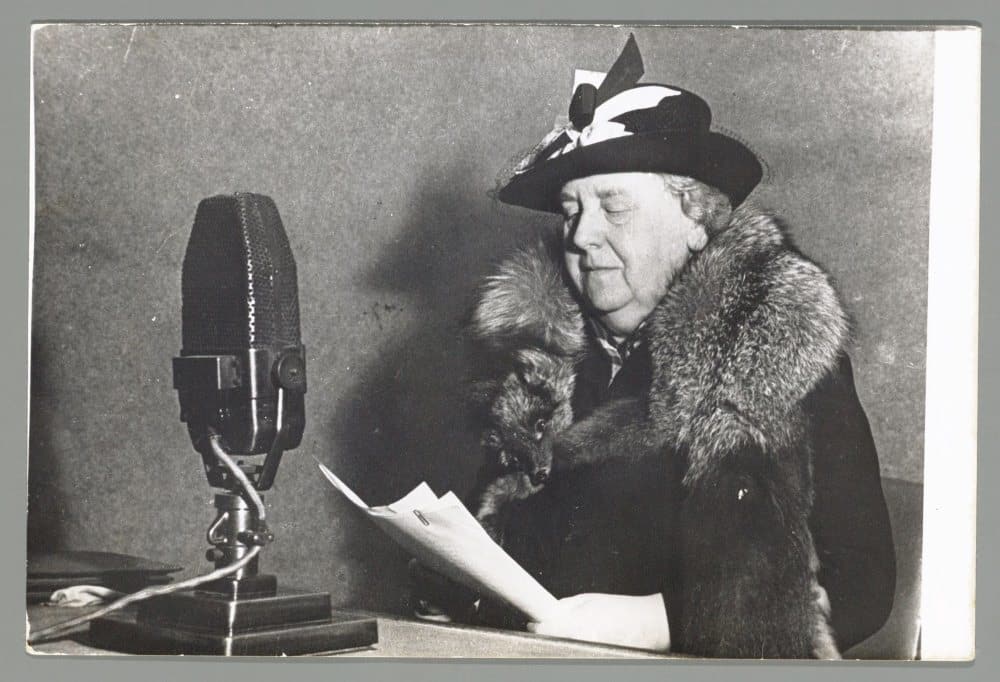 The Dutch Queen Wilhelmina addresses the people via Radio Oranje in the summer of 1940.
The Dutch Queen Wilhelmina addresses the people via Radio Oranje in the summer of 1940.© ANEFO - National Archives
Walking on eggs
In 2020, these uncommon speech events provide an opportunity for a king like Willem-Alexander of the Netherlands, who wants to “connect, represent and encourage aspirations.” But every royal speech is equally an exercise in walking on eggs. Above all there can be no mistakes – critics of all kinds are sharpening their knives.
The monarchs’ corona speeches in March 2020 primarily had the goals of comforting the populace and encouraging everyone to work together to combat the crisis. There is information about the substantive side of these speeches and the finesse of the formulation here (in Dutch). But it also comes down to what the classical rhetoricians called actio; that is, the quality of the voice, breath, gaze, posture and gestures as well as the often-overlooked aspect of televised eloquence – visual rhetoric – the overarching image created with props and decor.
Filip’s crackling fireplace
One example of a prop that painfully distorted the message was the fireplace, lit and crackling, and the luxurious palace decor that served as the backdrop for the Belgian king’s December 2018 message (‘inequality, poverty, bigotry and climate change are social problems that require comprehensive solutions’). The setting was not in line with the sentiment of certain parts of the address.
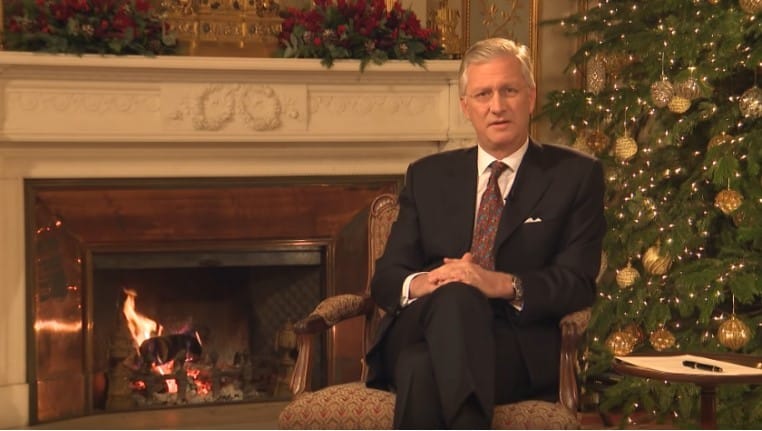 King Filip of Belgium in December 2018.
King Filip of Belgium in December 2018.Whatever burned in Filip’s Christmas address a year later, it was not in any case a fire in his fireplace.
Viewers who put these backgrounds in the foreground of their analysis notice some striking things. Why are those books and artifacts placed in the scene? What do they reveal about the monarch’s ambitions?
The list of players
Let me introduce the seven lead players. The first to appear in a televised address about the corona crisis was King Harald of Norway on 15 March. Without any opening music or external views of his palace, there he sat, at his desk, to read his speech, which was printed out on two sheets of paper. At 280 words, it was the shortest address and only took two-and-a-half minutes.
Queen Margrethe of Denmark spoke two days later and for twice as long. Her speech served as a direct mouthpiece of cabinet policy and contained a significant amount of practical advice for dealing with corona.
In the longest of the seven speeches (808 words), King Felipe of Spain stressed the importance of unity in a seriously divided Spain. And not without reason: while he was speaking, separatists banged pots and pans on their balconies in a demonstration against the Spanish state.
King Filip of Belgium also spoke very briefly (255 words in 2 minutes and 38 seconds total speaking time). Perhaps to mask the brevity of his performance, he was also amongst the slowest speakers at 96 words per minute. Indeed, the opening shots of the palace from all sides, accompanied by a nationalistic musical score, took up most of the broadcasting time. His task is, of course, twice as challenging because he had to give the speech in both Dutch and French.
Dutch King Willem-Alexander spoke for almost the longest time and was almost the fastest talker (at an average of 121 words per minute). He appeared to search for the shortest sentences in the printed text of his speech, which must have made for much easier reading.
It was not until 5 April, Palm Sunday, that Swedish King Gustav
gave his speech. As the representative of the European country with the most liberal approach to the corona crisis, he made many references in his speech to the upcoming Easter festivities.
Queen Elizabeth, the oldest monarch at 93, was at first most noticeable by her absence. But then, like Gustav, she broke her silence on 5 April. She presented a text of average length and, without seeming to rush at all, reached the highest speech rate at 125 words per minute. And she set another record: her sentences averaged around 25-words in length, reminiscent of Obama. Long sentences are never recommended by professional speech writers because of the risk of mistakes and improper emphases. Still, she managed to get her long sentences out in a genuine and fluent manner.
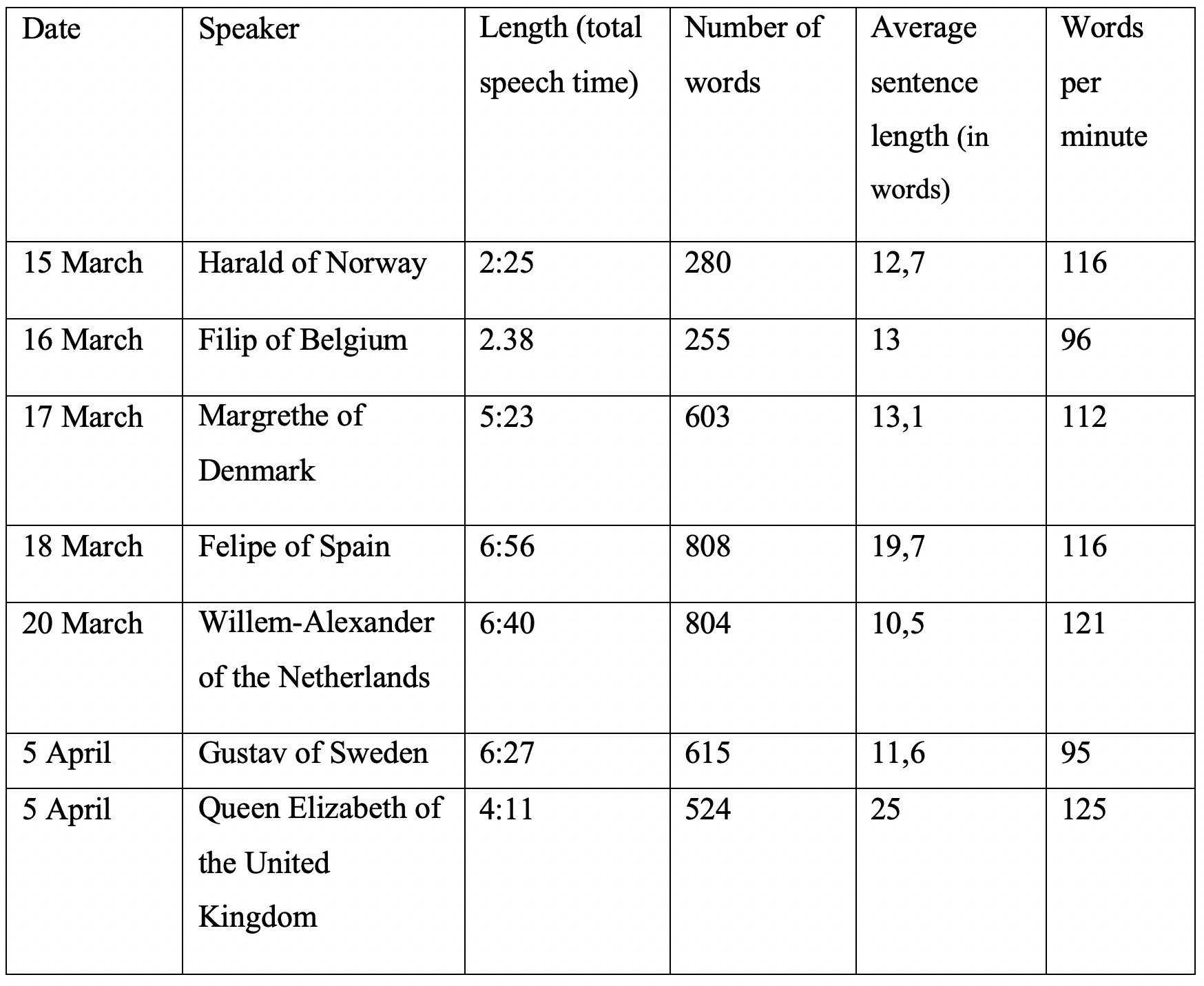
Droning on
And what did viewers see? Often, the first images were of the building in which the speech was given. With or without any musical accompaniment we saw the landscapes surrounding the palaces. The British drone photos made Windsor Castle a feast for the eyes. For the ultra-short speech of King Filip, viewers were treated to some touristic sight-seeing: the architecture of the palace and its surroundings were lovely before the cameras zoomed-in on the speaker. The broadcasts of Filip and Felipe’s addresses showed the national flags waving in the wind; but Felipe was the only one to show an interior shot of the EU flag standing next to that of Spain.
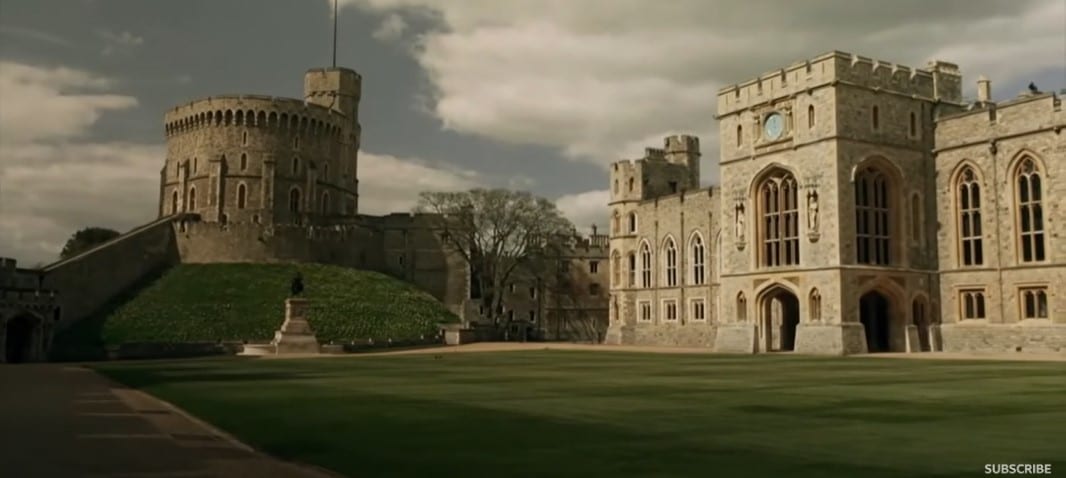 Windsor Castle in Queen Elizabeth's corona speech.
Windsor Castle in Queen Elizabeth's corona speech.Usually, the next shots were of the room where the monarch would be giving the speech: the office of the king or queen. This stereotypical view of the locale for a corona speech looks nothing like the average office. No sleek interior, fluorescent lights or office furniture; no abstract art on the walls, no modern communication tools such as monitors, laptops, tablets, smartphones; no smartboard on the wall. The monarch, talking, sits at a desk in a half-lit space containing burning candles, chandeliers and table lamps with candle-shaped lightbulbs of the old-fashioned, atmospheric type. Worth noticing, those candles, because after all, it’s not Christmas. The whole picture, with detailed wall decor, gold panelling and murals exudes class and distinction. Viewers are clearly not at home.
No Bible, but there is a Koran
Dominating the scene are classic writing utensils, pots and silver ornaments on the dark, high-quality desk, flowers (a beautiful and subtly-coloured bouquet for Margrethe, a plant with red flowers for Elizabeth and a huge bunch of while tulips for Harald) and books. Shelves of books symbolise tradition, knowledge and wisdom – things that are not without importance in times of crisis. In the cases of Gustav and Filip, who likes to be known as someone who reads a lot, there are many books in leather bindings, meaning, alas, that we cannot discern the titles.
King Salman of Saudi Arabia, the Guardian of Mecca, who is playing a guest role in this comparison of European monarchs, leaves us in no doubt: the book on view during his speech to the people from a golden palace hall on 19 March has got to be the holy book of Islam, the Koran. In the Christmas Speeches of Queen Elizabeth – head of the Anglican Church – a Bible used to figure prominently, but these days, it is left off-stage so as not to exclude non-believers.
No visual props or symbols of the season, such as Christmas trees or palm branches, appear on the corona sets. We are not shown any artifacts that might cause offense, for example, hunting trophies that might upset animal lovers. What we do see are pots and, in Harald’s cabin (evoking the holiday homes in nature so dear to the Scandinavians), an impressive collection of silver ornaments shines forth. Margrethe displays a white statue of hands holding a heart: ‘safe’ art with a positive message. Slightly risky is the porcelain carriage pulled by six porcelain horses: the members of the Dutch Party for Animals might consider this a step too far. Within five years, this prop will suffer the same fate as Filip’s crackling hearth fire. It’s all about details.
Family photos
What we do see in almost every case is photographs. More specifically: family photos. Or we can assume so; though, in fact, the televised set is usually not clear enough for us to see who is actually in the photos. (A joke circulating on social media suggests that, in place of his three daughters, Willem-Alexander has a photo of the pop group K3 on his desk.) Yet the photos are undoubtedly carefully chosen. The people in the photos are ‘in favour’. These family photos – of parents, children and grandchildren – express not only general family values but also the worth of The Royal Family. Salman’s backdrop features an immense portrait of his father, the founder of the Saud Dynasty (as if it must be visually stressed that the present King Salman is truly the descendant of his ancestor). The portraits are images of a unique, national family. Politicians come and go, but these families with the familiar faces of past, present and future will always be with us.
And how do the monarchs see themselves? In this crisis period, gravitas is the message. The men wear dark suits, white shirts, and chic ties; their military uniforms and medals remain in the closet. Salman brightens up the tableau with a cloak trimmed in gold and a traditional red and white head-covering with black trim. The ladies are also soberly dressed: Margrethe in a moody burgundy and Elizabeth, as ever, in a simple monochrome suit (this time in green, the colour of hope) – with, of course, the requisite pearls.
Drunken cameraman
A mere talking head makes for tough television. Careful camera angles and clever zooming-in and -out combined with careful changes in perspective can support the message.
The camera work and lighting in Gustav’s case was carefully managed and the zoom-ins and -outs added impact and depth to his words. Willem-Alexander also benefitted from sufficient variations that were neither too emphatic nor too distracting.
The Belgian drone shots raised expectations in the beginning, but the camera work afterwards did not really deliver: the merciless zoom-ins on Filip only served to enhance his unease in delivering the Dutch language text. His hands did not move at all and his stiff, unfocused face expressed barely any emotion.
The camera work for Salman was nothing short of amateurish. It was as if the cameraman had discovered the zoom function for the first time so that too often, and without any rhetorical reason, the length of the shots kept changing. Naturally, there are some differences surrounding visual culture, but this was either rank amateurism – or drunkenness.
Elocution
Salman may not have noticed the antics of his drunken cameraman since he limited his eye contact to the paper from which he was reading. He kept touching his face and made a meal of turning his text over. In that room filled with brown and gold draperies, it was all about the text being read. Harald, Gustave and Margrethe also read their texts. Harald had his text printed on two large pieces of paper laying on his desk and almost never looked at the camera – or, thus, at the audience. When he did glance up, we saw a closed, mournful face. His hands, from the elbows down, remained invisible under the desk. The speech seemed to be a chore, rather than any kind of communication opportunity. Gustav and Margrethe also read from printed texts but made conscious efforts to look at the camera; though it was striking how Margrethe struggled with turning the horizontally printed pages over and spread them out several times. However, her lovely voice and friendly face made up for a lot.
Willem-Alexander, Filip, Felipe and Elizabeth made the most of technology and used an autocue, which allowed them to maintain eye-contact with the viewers almost 100 percent of the time. Felipe was the only one who spoke standing up: and also used extensive gestures to give power to his words. They looked natural. Filip and Elizabeth were almost motionless in posture and gesture. Those who opt to remain static must compensate with facial expressions (such as expressive eyebrows) and vocal quality to create dynamism. Filip’s stiff expression and flat voice did not compensate.
Dutch newspaper Trouw characterised Willem-Alexander’s speech as ‘wooden’. Relative to the other monarchs, this is a bit too severe in my opinion. The serious, concerned look, the limited melody in his compassionate voice, his natural facial expression and the (scant) gestures used to emphasise his words suited the seriousness of a crisis speech. His breathing was sometimes disturbing and less than musical, but then breath control while speaking is one of the most difficult things to master.
Mediacracy
A monarch giving a speech – a talking head of state – is not simply good television. The entire event, of course, hinges in the first place on the content of the speech. Sometimes the authenticity of a wooden or more improvised presentation can have great effect. Consider Beatrix after the Queen’s Day attacks in Apeldoorn, her heartfelt sighs in a non-descript space.
Even the stuttering speeches of king George were considered comforting by many. But in our present-day mediacracy the settings and delivery of a speech matter quite a lot. In corona speeches, the paraphernalia that provides some visual grandeur during the sometimes bloodless compromise formulations of the annual speeches from the throne was not removed: the horses in front of the – questionable, potentially “racist” – painted golden carriage, the parades and hat folklore. The backdrops and production details can contribute to the message. Or detract from it.
The most experienced monarch, Elizabeth, understands the laws of the mediacracy. She waits, has the last word, and delivers an impressive address in a modern style thanks to the autocue. While Prime Minister Boris Johnson was out of the picture as a corona patient, she offered comfort and, by leaving the divisive Brexit struggle on the back burner, strengthened the national identity.
Meme of the queen
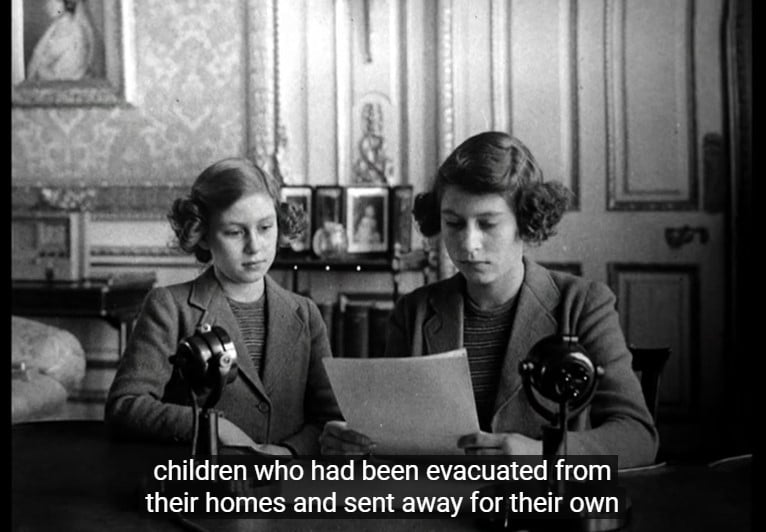 Queen Elizabeth and her sister in 1944.
Queen Elizabeth and her sister in 1944.She did this through a controlled and concerned presentation that was interspersed three times – under the guidance of her director – with attention-getting and emotional images of hardworking nursing staff, transport workers, citizens standing outside applauding the heroes of the moment, children’s colourful rainbow drawings and, finally, a proven visual prop: a photo of herself when she and her sister gave a radio address from Windsor Castle in 1944. Everyone can draw the same conclusion: just like they did in wartime, Great Britain and her queen will come through this crisis.
The static, speaking queen presents a perfect picture, with a sober but rich background free of any distractions except the well-chosen supporting images. Her sentences sound fluid, musical and clear – seemingly without effort – and yet also concerned and authentic – a combination the Saudi, Belgian and Norwegian royal families probably dream of. We’ll Meet Again, the war song used in the peroration, achieved maximum effect precisely because it was not mentioned or ‘performed’. It buzzed in the media – both in old newsreels and through modern channels – as a memory of a difficult moment in history when the monarch and her people conquered together; a viral meme of the queen.


